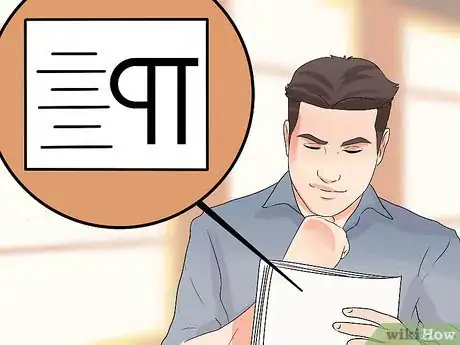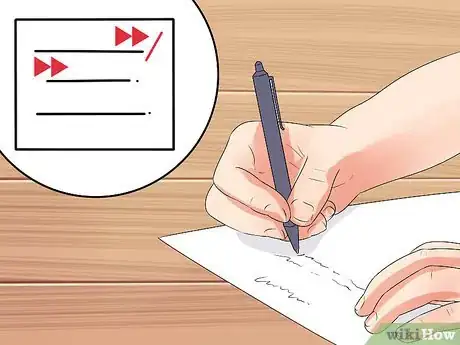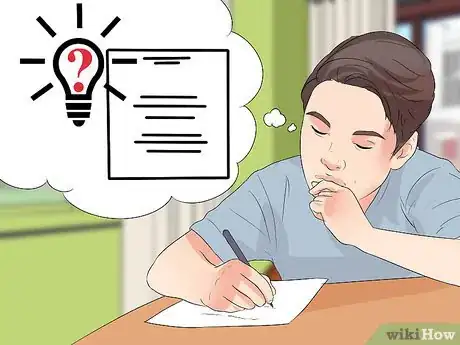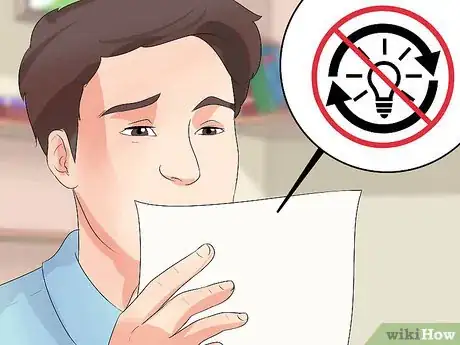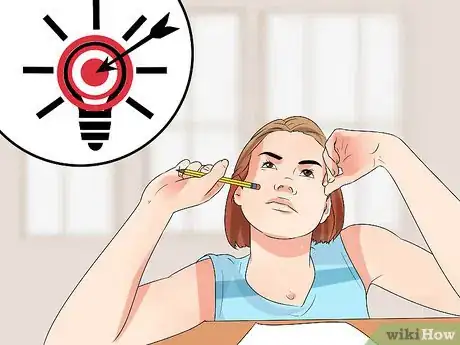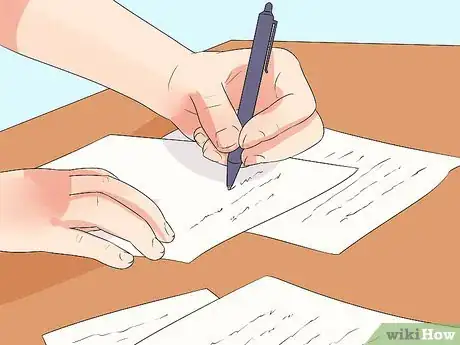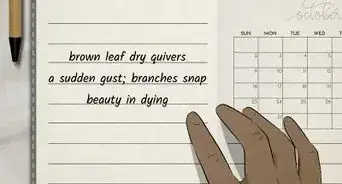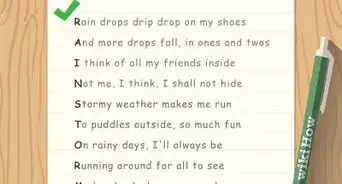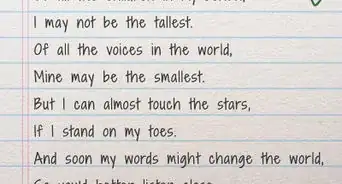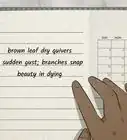This article was co-authored by Christopher Taylor, PhD. Christopher Taylor is an Adjunct Assistant Professor of English at Austin Community College in Texas. He received his PhD in English Literature and Medieval Studies from the University of Texas at Austin in 2014.
There are 10 references cited in this article, which can be found at the bottom of the page.
This article has been viewed 65,855 times.
Writing poetry can be a fun, fulfilling hobby. You may feel your poems should mean something, have a deeper message for readers to discover. There are many ways you can make a poem meaningful for you. To start, brainstorm ideas about the kind of meaning you want to convey. From there, think about the type of poem you want to write. Then, work on using poetic language and literary techniques to write your poem. When you're finished, you can revise your poem.
Steps
Brainstorming and Prewriting
-
1Freewrite about topics that mean something to you. If you want to write a meaningful poem, you should go into it with an idea of what you're trying to convey. Poems can be about a variety of topics: love, loss, grief, excitement, joy. They can also be about anything that inspires you from a work of art to a blade of grass. It can help to sit down and do a 10 to 15-minute free write. Think about what's meaningful to you, and just start writing.
- You may start with a list. For example, you may ask yourself, "What things are most meaningful to me?" You may start writing, "my family, my friends, my pet dog, sports, etc., etc."
- As you list topics, one may stand out to you as particularly meaningful. You may want to start talking about why that subjects means so much to you, what moments or images capture that meaning. For example, maybe grief is a major issue for you. You may want to jot down your experiences grieving, what you think it means to grieve, why the process is necessary, and so on.
-
2Read other poets. If you want to write anything of meaning, reading is invaluable. Almost all poets communicate using figurative language, and most poems have some meaning under the surface. Before trying to write your own poem, read works by a variety of poets to help inspire you.
- Read the kind of poems you want to write. If you're interested in free verse poetry, you can read the works of writers like TS Eliot, Walt Whitman, Emily Dickinson, William Carlos Williams, and Ezra Pound. If you want more structured poems, look into sonnets like those written by Robert Lowell, William Shakespeare, and John Berryman.[1] Also, consider topic. If you're interested in nature poems, poets like Gary Snyder and Mary Oliver frequently write about nature.[2]
- As you read, search for meaning. Try to see how the writers made their meaning apparent. Look for figurative language including symbolism, metaphors, similes, imagery, and repetition. You may want to look online for analyses of poems you like. Reading literary analysis can help show you how poets create meaning with their words.
Advertisement -
3Choose a structure. Poetry is a vast art form. There are many different types of poems. Some, like the haiku or the sonnet, are more structured. Some, like free verse, tend to allow for less structure. Think about the type of poem you want to write before you begin.[3]
- Some forms of poetry have strict requirements. Sonnets, for example, must have 14 lines of 10 syllables each. Other forms of poetry, like haikus and limericks, also come with strict structures.[4] A strict structure can help you organize your thoughts, but also may constrict them.
- Other structures, namely free verse, allow you to write poetry without a specific structure in mind. There is no set meter or rhyming patterns in a free verse poem.[5] Lyric poems are rhythmic, expressive poems in which a speaker expresses personal feelings.
- Even if you're not using a strict structure, poetry should have a musical flow. It's a good idea to track syllables and read the poem out loud as you go, making sure the rhythm you've established does not feel clunky.[6]
-
4Select your point of view. Poetry, like prose, is written from a specific point of view. The point of view is the lens through which a poem is told. The point of view you choose for your poem can help you convey your specific meaning.[7]
- First person point of view uses words like "I," "me," and "we." It gives the sense the poet's narrator is speaking from direct experience. If you see yourself as the narrator of your poem, you may want to use first person. This can be especially helpful if your poem's meaning is very personal.
- Second person point of view uses words like "you." It gives the reader the sense they're being addressed, or what's happening in the poem is happening to them. If you're trying to address readers in your poem, second person can be helpful. You can also use it to try to put readers in the moment, encouraging them to imagine the action is happening to them.
- Third person uses pronouns like "he/she" and "him/her." You may be writing a meaningful poem about something you have not directly experienced, like a historical event for example. In this case, it may be appropriate to use third person to show the reader the narrator is an outside observer.
Writing Your Poem
-
1Establish your theme. Once you're ready to write your poem, you can start by establishing your theme. This will be an important tool to you as you write. From prewriting, you should have a sense of what you want to write about. Try to, in a single theme statement, explain your message regarding that subject.[8]
- Returning to an earlier example, say your topic is grief. You lost your mother when you were young, and you would like to write about what you learned from this experience. Your topic is grief, and your theme will be what you learned in the grieving process.
- In a single sentence, try to write down what you're trying to say. This may take several attempts. It's okay to write a long paragraph at first, and then figure out how to boil down that meaning in a single sentence. Using the above example, you may end up with a sentence like, "Grief can change over time, and even lessen, but it's something that never truly leaves someone."
-
2Use poetic devices to create meaning. You can bring out meaning in a poem by using devices such as symbolism, synecdoche, metonymy, repetition, simile, and metaphor. Experiment with different devices to see what best fits the statement you are trying to express, and what comes most naturally to you as a writer.[9]
- Similes and metaphors are comparisons, in which one thing is compared to another. "Your love is a red dress" is a metaphor. A simile is a metaphor that uses "like" or "as." "Your love is like a red dress" is a simile.
- Synecdoche is a figure of speech wherein a term for a part of a thing or concept is used in reference to the whole ("Check out my new set of wheels"). Metonymy is a similar figure in which a thing or concept is referred to by the name of something closely associated with it ("The pen is mightier than the sword.")
-
3Convey feeling in images. Images are a wonderful tool in poetry. A lot of feeling, emotion, and meaning is best conveyed through images. Sometimes, it's better to show your reader meaning through symbolic imagery than say it overtly. There are many different ways you can use images to convey feeling.[10]
- Focus on a single moment. Maybe, returning to our grief example, you once watched a baby foal stand up for the first time. This can be used to show the difficulty to stand metaphorically after grief.
- Describe something or someone. The more you describe certain images, the more meaningful they become. Think back to the grief example. If you're using a metaphor involving a long road, spend a lot of time focusing in on descriptions of that road. You can describe some parts of the road as light and easy, while others are dark and frightening. This helps show how grief changes, but still remains, and the fact the road is described in such detail will alert your readers to its importance.
-
4Steal snippets of conversation. Writers borrow a lot from real life and use it to convey meaning. Some poems contain a bit of dialogue, and certain conversations can convey your meaning. If it helps, you can include snippets of conversation into your poem.[11]
- You can include real life snippets of conversation. Using the example, you may want to include bits and pieces of conversations you had during your mother's funeral that were personally meaningful.
- You can also use overheard bits of conversation. Maybe you were once at an airport and sat next to a couple going home for a funeral. You may remember their conversation, and may want to include this scene or conversation in your poem.
-
5Make conscious choices about line breaks. Where you choose to break up lines in your poem can have a big impact on the poem's sound. This is particularly important for poems that do not rhyme, as the rhythm and musical nature of the poem is largely determined by line breaks. Line breaks can also help convey meaning.[12]
- There are many ways you can use line breaks to emphasize meaning. A line break can indicate a change in thought. Each new line can be a new insight. In the above example, you can have each line break indicate a slight change in grief's form, introducing new images.
- You should also pay attention to the sound produced by line breaks. The sound of a word that ends a line will stick out in a reader's mind. If you're trying to convey pain, choose hard words with hard consonants to end the line. If you're meaning to convey something tender, using soft consonants. Sounds like "sh", and words with vowels can help. This can mean words with many vowels, words that start with vowels, or words that end in vowels.
-
6Use enjambment. Enjambment is continuing a sentence beyond the end of a line without pausing. You could break up a single sentence into two or more lines. Enjambment creates a kind of tension in the poem. As the readers move their eyes down the page, they must keep reading in order to understand what is being said. This keeps readers curious, but also creates a certain tension. You should use enjambment for lines that are particularly meaningful or important in your poem, as this will call attention to them.[13]
- Let's return to the example. Your thesis is about how grief changes form, but remains. You could use enjambment when writing the line about the river, as this calls attention to this line. It creates a certain tension by spreading it out, making readers notice its importance.
-
7Remember your underlying meaning. When writing a meaningful poem, you have a wide variety of literary techniques from which to choose. It can get overwhelming to manage. If you're feeling overwhelmed by a poem, try returning to your theme. Remember what you're trying to convey. This can help you if you feel lost, as you can take a minute and ask yourself what you can include to make your theme apparent.
Revising Your Poem
-
1Watch out for cliche phrases. Cliche phrases are phrases that are overused to the point they lose meaning. You should avoid cliches in your poem, such as common comparisons. As you re-read the draft of your poem, watch for phrases like "eats like a bird" or "tired as a dog."[14]
- When you spot a cliche, consider what it means. The phrase "tired as a dog," for example, conveys a sense of exhaustion. Try to figure out a way to represent exhaustion that's more personally meaningful to you.
-
2Manage sentimentally. It's okay to be sentimental in writing. In fact, it may even be necessary in a meaningful poem. However, excessive emotion may come off as dishonest to readers. You have to make sure the moments and images in your poem stand out on their own. Gong overboard with hyperbolic language can turn a reader off.[15]
- Read through your poem and watch for areas where language seems over the top. If you're using very dramatic adjectives, like "glorious" or "heart-wrenching," this may read as too sentimental.
- Try to tone down sentimentality. It's good for a poem to be sentimental, and to have emotion. However, you want to lead readers to those emotions instead of forcing emotions on them. If you feel like some phrases are too overwrought, try rewriting them with less adjectives or hyperbole. You can also try conveying an emotion through an image instead.
-
3Make sure your meaning is conveyed. You should read through your poem and pause at each line. Ask yourself, "Am I conveying what I want to convey here?" Look for any words or images that do not match with your meaning. Even if you love certain lines, you should cut or alter them if they take away from your meaning.
- Using the grief example, maybe you're trying to show the difficulty of the beginning of grief. You realize you talk a bit about sunshine and flowers, which are happier images. You may want to move those images to a later part of the poem, or omit them altogether.
-
4Write a few drafts. No poem is every complete after a single draft. If you want to write meaningful poetry, revision is necessary. Set your poem aside for a few days and let yourself get some space. Then, reread it and revise as necessary. You should also consider showing your poem to others and asking for criticism and feedback.[16]
Community Q&A
-
QuestionHow do you write a good short poem?
 Christopher Taylor, PhDChristopher Taylor is an Adjunct Assistant Professor of English at Austin Community College in Texas. He received his PhD in English Literature and Medieval Studies from the University of Texas at Austin in 2014.
Christopher Taylor, PhDChristopher Taylor is an Adjunct Assistant Professor of English at Austin Community College in Texas. He received his PhD in English Literature and Medieval Studies from the University of Texas at Austin in 2014.
English Professor For a short poem, concision is key. Try to distill your subject into images or fragments in an effort to convey meaning in as few words as possible.
For a short poem, concision is key. Try to distill your subject into images or fragments in an effort to convey meaning in as few words as possible. -
QuestionHow do you start a poem?
 Christopher Taylor, PhDChristopher Taylor is an Adjunct Assistant Professor of English at Austin Community College in Texas. He received his PhD in English Literature and Medieval Studies from the University of Texas at Austin in 2014.
Christopher Taylor, PhDChristopher Taylor is an Adjunct Assistant Professor of English at Austin Community College in Texas. He received his PhD in English Literature and Medieval Studies from the University of Texas at Austin in 2014.
English Professor Do some freewriting to loosen up your mind and to find a topic or patterns that you want to play with. Once you have identified a central image, idea, or theme, determine what kind of structure you will give your poem and then try to write it.
Do some freewriting to loosen up your mind and to find a topic or patterns that you want to play with. Once you have identified a central image, idea, or theme, determine what kind of structure you will give your poem and then try to write it. -
QuestionHow do you write a simple poem?
 Christopher Taylor, PhDChristopher Taylor is an Adjunct Assistant Professor of English at Austin Community College in Texas. He received his PhD in English Literature and Medieval Studies from the University of Texas at Austin in 2014.
Christopher Taylor, PhDChristopher Taylor is an Adjunct Assistant Professor of English at Austin Community College in Texas. He received his PhD in English Literature and Medieval Studies from the University of Texas at Austin in 2014.
English Professor Identify a topic, idea, or image you want to write about and choose a structure in which to frame your poem. Try and convey something about your central idea using words that fit into the structure you chose.
Identify a topic, idea, or image you want to write about and choose a structure in which to frame your poem. Try and convey something about your central idea using words that fit into the structure you chose.
References
- ↑ https://www.poets.org/poetsorg/text/sonnet
- ↑ https://www.poets.org/poetsorg/text/nature-poems
- ↑ https://www.youngwriters.co.uk/glossary-poetry-types
- ↑ https://www.youngwriters.co.uk/types-sonnet
- ↑ https://www.youngwriters.co.uk/types-sonnet
- ↑ http://www.surfnetkids.com/valentinesday/1161/tips-for-writing-a-meaningful-and-unique-love-poem/
- ↑ http://literarydevices.net/point-of-view/
- ↑ http://jerz.setonhill.edu/writing/creative1/poetry-writing-tips-how-to-write-a-poem/
- ↑ http://jerz.setonhill.edu/writing/creative1/poetry-writing-tips-how-to-write-a-poem/
- ↑ http://www.writersdigest.com/editor-blogs/poetic-asides/advice/5-ways-how-to-write-a-poem
- ↑ http://www.writersdigest.com/editor-blogs/poetic-asides/advice/5-ways-how-to-write-a-poem
- ↑ https://www.poetryfoundation.org/articles/70144/learning-the-poetic-line#article
- ↑ https://www.poetryfoundation.org/articles/70144/learning-the-poetic-line#article
- ↑ http://jerz.setonhill.edu/writing/creative1/poetry-writing-tips-how-to-write-a-poem/
- ↑ http://numerocinqmagazine.com/2010/10/25/theres-a-reason-they-call-it-show-and-tell-how-to-reveal-thoughts-emotions-and-motivations-without-sentimentality-a-lecture-by-laura-rose-russell/
- ↑ http://jerz.setonhill.edu/writing/creative1/poetry-writing-tips-how-to-write-a-poem/
About This Article
To write a meaningful poem, start by establishing a main theme to base your poem around. Next, come up with fitting descriptions, imagery, and symbolism that match your theme and consider using other devices like similes and metaphors to create additional layers of meaning. You can also add meaning by consciously using line breaks to introduce different sounds and convey changes in thought or emotion. Periodically remind yourself of your theme so that you don't stray too far away from it! For tips on revisions that can help you enhance your poem's meaning, read on!








